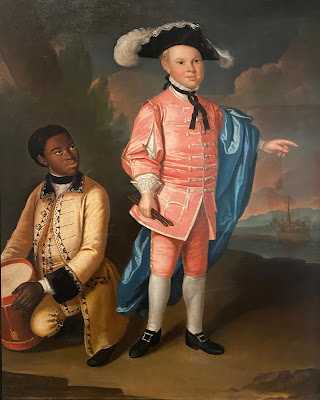As an undergraduate at Columbia, I took a "History of Photography" course that required reviewing a contemporary exhibition. I chose "New Japanese Photography" at the Museum of Modern Art and wrote about how it made me question the necessity of dropping atomic bombs on Hiroshima and Nagasaki to end World War II after seeing contemporary photos that documented the effects of that strategy on the civilian population 30 years later. My passion earned me a rare "A."
"Unnamed Figures: Black Presence and Absence in the Early American North" at the American Folk Art Museum provided a similar epiphany when I learned that mid-19th century African Americans with change to spare were a huge market for newly created commercial photography studios. For most, it was their first opportunity to have their likenesses depicted in a realistic, non-racist way. Beaumont Newhall declined to make that point in The History of Photography, published by the MoMA in 1964 and the Bible of my college course. I just double-checked. Yep, I've still got the book.
Of course, there were early exceptions like Phyllis Wheatley and later, Frederick Douglass, both of whom were famous enough to receive respectful treatment. This etching of Wheatley illustrated an edition of her 18th-century poetry.
For the most part, African Americans were missing from the folk art of the era or depicted in positions of subjugation which is more obvious in some works than others. The youth of these two finely dressed subjects in Maryland disguises their relationship until you read the painting's title.
 |
| "Charles Calvert & Once-Known Enslaved Attendant by John Hesselius (1761) |
One Connecticut slave-holder chose to include her nursemaid in a needlepoint that depicts her lifespan, suggesting that relationship was among the most important in her life and probably continued into adulthood.
A line engraving illustrates the population of a prison in Connecticut which, at the time, had more people enslaved than any other state in New England. The artist, who may have been a prisoner himself, depicts the faces of white inmates in some detail while the black men are defined strictly by their color. The whites, however, vastly outnumber the blacks in this pre-13th-amendment environment.
 |
| "A Prospective View of Old Newgate, Connecticut's State Prison by Richard Brunton (ca 1799) |
Although New York State had abolished slavery by the time this work was painted, notice that the casual strollers all are white and the laborers black.
Racists often have decorated their homes with "lawn jockeys" but the intent behind this unpainted limestone sculpture from the early 19th century is more ambiguous given the dignity of his features.
That ambiguity is missing in these 19th century works.
 |
| Minstrel Show Diorama |
Kara Walker appropriated the original title of the painting below to comment on racist art in Darkytown Rebellion.
 |
| Town Scene (formerly known as "Darkytown") by Unknown Artist (ca 1860-1880) |
"Marvels of My Own Inventiveness," another exhibit at the museum provided some welcome relief with works created by contemporary black artists.
 |
| Untitled by Leonard Daley (ca 1990s) |
 |
| Untitled (I LURN ABCD) by Mary T. Smith (ca 1975-1989) |
 |
| Untitled (HEAR) by Mary T. Smith (partial, ca 1980) |







No comments:
Post a Comment